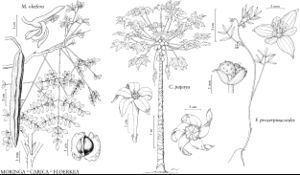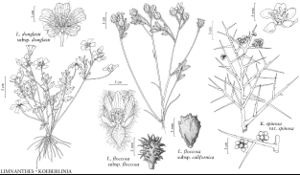Difference between revisions of "Limnanthaceae"
FNA>Volume Importer |
imported>Volume Importer |
||
| (6 intermediate revisions by 2 users not shown) | |||
| Line 13: | Line 13: | ||
}}<!-- | }}<!-- | ||
| − | --><span class="statement" id="st-undefined" data-properties=""><b>Herbs,</b> annual; glabrous or pubescent (not glandular; producing glucosinolates). <b>Stems</b> erect, decumbent, or sprawling; unbranched. <b>Leaves</b> alternate, simple or compound; venation pinnate; stipules absent; petiole present; blade margins entire or pinnately lobed, bipinnate, or ternate. <b>Inflorescences</b> axillary, flowers solitary; bracts absent. <b>Pedicels</b> present. <b>Flowers</b> usually bisexual, usually actinomorphic, rotate; perianth and androecium hypogynous; sepals usually persistent, 3 or 5 (4 in Limnanthes macounii), distinct or slightly connate basally, equal or unequal; petals same number as sepals, convolute in bud, distinct, equal; nectary glands present; stamens 3, 6, 8, or 10 (same or twice the number of sepals); filaments distinct, glabrous; anthers dehiscing by longitudinal slits, introrse or extrorse, tetrasporangiate, pollen shed in single grains, binucleate, 2–4-aperturate, colpate or colporate; disc absent; gynophore absent; pistil 1; ovary 2–5-carpellate, syncarpous basally (united by gynobasic style); placentation basal; ovules 1 per locule, anatropous, unitegmic; style 1 (gynobasic); stigmas (2 or) 3–5 (dry, papillate). <b>Fruits</b> schizocarps (mericarps or nutlets), tuberculate, ridged, smooth, or rugulose. <b>Seeds</b> 1; not arillate; endosperm absent.</span><!-- | + | --><span class="statement" id="st-undefined" data-properties=""><b>Herbs,</b> annual; glabrous or pubescent (not glandular; producing glucosinolates). <b>Stems</b> erect, decumbent, or sprawling; unbranched. <b>Leaves</b> alternate, simple or compound; venation pinnate; stipules absent; petiole present; blade margins entire or pinnately lobed, bipinnate, or ternate. <b>Inflorescences</b> axillary, flowers solitary; bracts absent. <b>Pedicels</b> present. <b>Flowers</b> usually bisexual, usually actinomorphic, rotate; perianth and androecium hypogynous; sepals usually persistent, 3 or 5 (4 in <i>Limnanthes macounii</i>), distinct or slightly connate basally, equal or unequal; petals same number as sepals, convolute in bud, distinct, equal; nectary glands present; stamens 3, 6, 8, or 10 (same or twice the number of sepals); filaments distinct, glabrous; anthers dehiscing by longitudinal slits, introrse or extrorse, tetrasporangiate, pollen shed in single grains, binucleate, 2–4-aperturate, colpate or colporate; disc absent; gynophore absent; pistil 1; ovary 2–5-carpellate, syncarpous basally (united by gynobasic style); placentation basal; ovules 1 per locule, anatropous, unitegmic; style 1 (gynobasic); stigmas (2 or) 3–5 (dry, papillate). <b>Fruits</b> schizocarps (mericarps or nutlets), tuberculate, ridged, smooth, or rugulose. <b>Seeds</b> 1; not arillate; endosperm absent.</span><!-- |
-->{{Treatment/Body | -->{{Treatment/Body | ||
| Line 19: | Line 19: | ||
|discussion=<p>Genera 2, species 8 (8 in the flora).</p><!-- | |discussion=<p>Genera 2, species 8 (8 in the flora).</p><!-- | ||
--><p>Placement of Limnanthaceae in Brassicales is supported by molecular and chemical data, especially the presence of mustard oils. Traditionally (A. Cronquist 1981), the family has been associated with the Geraniaceae in the Geraniales because of the similarity of habit and floral structure, especially the fruits that separate into mericarps, as do those in Geraniaceae.</p><!-- | --><p>Placement of Limnanthaceae in Brassicales is supported by molecular and chemical data, especially the presence of mustard oils. Traditionally (A. Cronquist 1981), the family has been associated with the Geraniaceae in the Geraniales because of the similarity of habit and floral structure, especially the fruits that separate into mericarps, as do those in Geraniaceae.</p><!-- | ||
| − | --><p>Limnanthaceae are endemic to North America. The greatest diversity is in California, where most of the species of Limnanthes occur. Floerkea, with a single species, occurs widely across the continent; it is barely present in the southeastern United States.</p> | + | --><p>Limnanthaceae are endemic to North America. The greatest diversity is in California, where most of the species of <i>Limnanthes</i> occur. <i>Floerkea</i>, with a single species, occurs widely across the continent; it is barely present in the southeastern United States.</p> |
|tables= | |tables= | ||
|references={{Treatment/Reference | |references={{Treatment/Reference | ||
| Line 65: | Line 65: | ||
|family=Limnanthaceae | |family=Limnanthaceae | ||
|illustrator=Barbara Alongi | |illustrator=Barbara Alongi | ||
| + | |illustration copyright=Flora of North America Association | ||
|distribution=North America. | |distribution=North America. | ||
|reference=link1992a;ornduff1968a;ornduff1971a;parker1979a;plotkin1998a | |reference=link1992a;ornduff1968a;ornduff1971a;parker1979a;plotkin1998a | ||
| Line 70: | Line 71: | ||
|publication year= | |publication year= | ||
|special status= | |special status= | ||
| − | |source xml=https:// | + | |source xml=https://bitbucket.org/aafc-mbb/fna-data-curation/src/2e0870ddd59836b60bcf96646a41e87ea5a5943a/coarse_grained_fna_xml/V7/V7_206.xml |
}}<!-- | }}<!-- | ||
-->[[Category:Treatment]] | -->[[Category:Treatment]] | ||
Latest revision as of 22:32, 5 November 2020
Herbs, annual; glabrous or pubescent (not glandular; producing glucosinolates). Stems erect, decumbent, or sprawling; unbranched. Leaves alternate, simple or compound; venation pinnate; stipules absent; petiole present; blade margins entire or pinnately lobed, bipinnate, or ternate. Inflorescences axillary, flowers solitary; bracts absent. Pedicels present. Flowers usually bisexual, usually actinomorphic, rotate; perianth and androecium hypogynous; sepals usually persistent, 3 or 5 (4 in Limnanthes macounii), distinct or slightly connate basally, equal or unequal; petals same number as sepals, convolute in bud, distinct, equal; nectary glands present; stamens 3, 6, 8, or 10 (same or twice the number of sepals); filaments distinct, glabrous; anthers dehiscing by longitudinal slits, introrse or extrorse, tetrasporangiate, pollen shed in single grains, binucleate, 2–4-aperturate, colpate or colporate; disc absent; gynophore absent; pistil 1; ovary 2–5-carpellate, syncarpous basally (united by gynobasic style); placentation basal; ovules 1 per locule, anatropous, unitegmic; style 1 (gynobasic); stigmas (2 or) 3–5 (dry, papillate). Fruits schizocarps (mericarps or nutlets), tuberculate, ridged, smooth, or rugulose. Seeds 1; not arillate; endosperm absent.
Distribution
North America.
Discussion
Genera 2, species 8 (8 in the flora).
Placement of Limnanthaceae in Brassicales is supported by molecular and chemical data, especially the presence of mustard oils. Traditionally (A. Cronquist 1981), the family has been associated with the Geraniaceae in the Geraniales because of the similarity of habit and floral structure, especially the fruits that separate into mericarps, as do those in Geraniaceae.
Limnanthaceae are endemic to North America. The greatest diversity is in California, where most of the species of Limnanthes occur. Floerkea, with a single species, occurs widely across the continent; it is barely present in the southeastern United States.
Selected References
Lower Taxa
Illustrations
Key
| 1 | Petals and sepals 3; petals shorter than sepals; stamens 3 or 6. | Floerkea |
| 1 | Petals and sepals (4 or) 5; petals usually longer than sepals; stamens 8 or 10. | Limnanthes |

